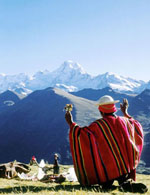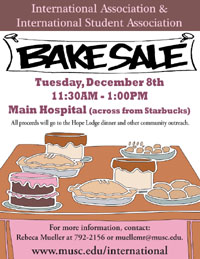|
Editor's
note: Welcome to the Global Health page. The purpose of this feature is
to raise awareness of global health issues with an academic spirit to
help improve the quality of care provided to patients. E-mail
globalhealthnews@musc.edu.
by Milenka Arispe Angulo, Ph.D.
The Kallawaya people are farmers and traveling healers who live just
north of Lake Titicaca in the Andes of Bolivia. They claim to be direct
descendents of the Tiahuanaco who lived there around 800 A.D. and have
a vast knowledge of wild plants and their therapeutic uses.
Some historical sources cite the Kallawayas as the first to use the
dried bark of the cinchona tree, which is the source of quinine and was
used for many years to prevent and control malaria and other tropical
diseases. Similarly, the main alkaloid of the coca plant, cocaine, was
one of the first effective topical anesthetics used by the Kallawayas
and later adopted by medical science.
 A
Kallawaya performs a ritual offering to Pachamama (Mother Earth) at the
top of a mountain, where he would pray for balance and harmony on earth
while showing his respect for her. A
Kallawaya performs a ritual offering to Pachamama (Mother Earth) at the
top of a mountain, where he would pray for balance and harmony on earth
while showing his respect for her.
Kallawayas still heal the sick with traditional herbs and rituals that
date back to pre-Incan times. Their holistic approach involves a
lengthy discussion with the patient concerning the illness and an
examination of the physical surroundings.
It is understood that a
Kallawaya's knowledge is based on long years of training, and that he
acts according to a strict code of religious and moral values. In
remote areas throughout Bolivia when a person becomes ill, he or she
most likely will turn to traditional remedies. The reason is a
practical one, since traditional remedies are affordable and the costs
of modern health services often are not. For most subsistence farmers,
paying a doctor’s fees is simply beyond their means. Many rural
dwellers still turn to Kallawayas for health advice even though modern
physicians and free services are available, because they do not trust
them and perceive them too clinical and foreign to their culture.
 The Kallawayas continue to travel on foot, walking ancient Inca trails
despite modern means of transportation. They have ventured all over
Bolivia and into parts of Peru, Argentina, Chile, Ecuador, and even
Panama. The sight of a Kallawaya, wearing a brightly colored hand-woven
poncho of vicuña traversing country paths with his walking stick, is a
common one in the Bolivian highlands.
The Kallawayas continue to travel on foot, walking ancient Inca trails
despite modern means of transportation. They have ventured all over
Bolivia and into parts of Peru, Argentina, Chile, Ecuador, and even
Panama. The sight of a Kallawaya, wearing a brightly colored hand-woven
poncho of vicuña traversing country paths with his walking stick, is a
common one in the Bolivian highlands.
Kallawayas speak Spanish and various indigenous dialects, because of
their nomadic lifestyle. In addition, they have their own “secret”
language in which the knowledge of the Kallawaya medicine is handed
down from father to son through the generations.
Kallawayas do not quarrel with modern medicine. They consider that the
blending of modern and traditional techniques can make them more useful
to the rural villages that rely on their knowledge. As they state, “In
delicate cases, we need to know first aid, because natural medicine
cures more slowly.”
Interesting facts
Bolivia
(the Tibet of the Americas) lies at the heart of South America. In no
other country can you find up to 21,463 ft.-high snow-covered
mountains, as well as tropical jungles in the Amazon basin, geysers,
hot springs, salt lakes, plateaus, deserts and valleys.
 Bolivia’s population is culturally, racially and socially diverse.
Amerindian population is at 55 percent; the remaining 30 percent is
mestizo (mixed Amerindian and European), and around 15 percent are
white and other ethnicities. Therefore, Bolivia is where the sight of a
bowler-hatted Indian lady walking side by side with a businessman in a
three-piece suit is not uncommon.
Bolivia’s population is culturally, racially and socially diverse.
Amerindian population is at 55 percent; the remaining 30 percent is
mestizo (mixed Amerindian and European), and around 15 percent are
white and other ethnicities. Therefore, Bolivia is where the sight of a
bowler-hatted Indian lady walking side by side with a businessman in a
three-piece suit is not uncommon.
Bolivia seems to be the land of the “highest,” claiming the highest
commercial airport, highest capital city, highest salt lake, and the
highest navigable lake in the world. Bolivia’s Chacaltaya Glacier, once
known as the world’s highest ski run at 17,388 ft., has completely
melted away this year, serving as a vivid example of the effects of
climate change on the glaciers worldwide.
Here the high culture of the Incas had its origins. Simon Bolivar, who liberated South America, gave his name to this country.
Ché Guevara, the famous revolutionary, made his last stand here.

Visit http://www.musc.edu/international.
Friday, Sept. 25, 2009
|




 The Kallawayas continue to travel on foot, walking ancient Inca trails
despite modern means of transportation. They have ventured all over
Bolivia and into parts of Peru, Argentina, Chile, Ecuador, and even
Panama. The sight of a Kallawaya, wearing a brightly colored hand-woven
poncho of vicuña traversing country paths with his walking stick, is a
common one in the Bolivian highlands.
The Kallawayas continue to travel on foot, walking ancient Inca trails
despite modern means of transportation. They have ventured all over
Bolivia and into parts of Peru, Argentina, Chile, Ecuador, and even
Panama. The sight of a Kallawaya, wearing a brightly colored hand-woven
poncho of vicuña traversing country paths with his walking stick, is a
common one in the Bolivian highlands. Bolivia’s population is culturally, racially and socially diverse.
Amerindian population is at 55 percent; the remaining 30 percent is
mestizo (mixed Amerindian and European), and around 15 percent are
white and other ethnicities. Therefore, Bolivia is where the sight of a
bowler-hatted Indian lady walking side by side with a businessman in a
three-piece suit is not uncommon.
Bolivia’s population is culturally, racially and socially diverse.
Amerindian population is at 55 percent; the remaining 30 percent is
mestizo (mixed Amerindian and European), and around 15 percent are
white and other ethnicities. Therefore, Bolivia is where the sight of a
bowler-hatted Indian lady walking side by side with a businessman in a
three-piece suit is not uncommon. 